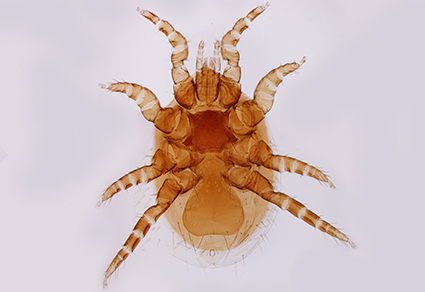Abstract
Mites of the subfamily Laelapinae parasitic on small mammals are remarkably diverse in the Neotropics. Within this subfamily, mites of the genus Mysolaelaps Fonseca, 1936 are endemic to the Neotropics and frequently associated with rodents of the tribe Oryzomyini (Cricetidae: Sigmodontinae). Currently, Mysolaelaps comprises three described species, exclusively on the bases of their morphology. This study aimed to provide molecular information of Mysolaelaps microspinosus Fonseca, 1936 and Mysolaelaps parvispinosus Fonseca, 1936 and analyze their phylogenetic relationships to other Laelapinae mites associated with rodents. Thirty-six mites were collected from Oligoryzomys flavescens (Waterhouse, 1837) from Argentina. Among them, 18 mites were identified as M. microspinosus and 18 as M. parvispinosus. A subsample of mites was submitted to DNA extraction and amplification of the nuclear region 18S-ITS1-5.8S-ITS2. The phylogenetic analyses indicated a closer relationship between Mysolaelaps and Laelaps Koch, 1836 than with mites of the genus Androlaelaps Berlese, 1903 and Gigantolaelaps Nesbitt, 1951. The present study highlighted the scarcity of information regarding the molecular biology of the genus Mysolaelaps and the importance of further molecular studies for understanding the evolutionary history of laelapid mites.
References
- Botelho, J.R., Linardi, P.M. & Maria, M. (2002) Alguns gêneros e subgêneros de Laelapidae (Acari: Mesostigmata) associados com roedores e revalidados por meio de taxonomia numérica. Lundiana, 3, 51–56. https://doi.org/10.35699/2675-5327.2002.21792
- Dowling, A.P. & OConnor, B.M. (2010) Phylogeny of Dermanyssoidea (Acari: Parasitiformes) suggests multiple origins of parasitism. Acarologia, 50, 113–129. https://doi.org/10.1051/acarologia/20101957
- Engelbrecht, A., Matthee, C., Ueckermann, E. & Matthee, S. (2014) Evidence of cryptic speciation in mesostigmatid mites from South Africa. Parasitology, 10, 1322–1332. https://doi.org/10.1017/S0031182014000584
- Fonseca, F. da (1936) Notas de Acareologia - XVIII. Generos e especies de acarianos parasitas de ratos (Acari, Laelapidae). Memórias do Instituto Butantan, 10, 17–23.
- Fonseca, F. da (1958) Notas de Acarologia - XLIV. Inquérito sôbre e fauna acarológica de parasitos no nordeste do Brasil. Memórias do Instituto Butantan, 28, 99–186.
- Furman, D.P. (1972) Mites of the family Laelapidae in Venezuela (Acarina: Laelapidae). Brigham Young University Science Bulletin Biological Series, 17, 1–58.
- Gettinger, D. & Gardner, S.L. (2017) Ectoparasitic mites of the genus Gigantolaelaps (Acari: Mesostigmata: Laelapidae) associated with small mammals of the genus Nephelomys (Rodentia: Sigmodontinae), including two new species from Peru. Acarologia, 57, 755–758. https://doi.org/10.24349/acarologia/20174191
- Gettinger, D., Martins-Hatano, F., Lareschi, M. & Malcolm, J. (2005) Laelapine mites (Acari: Laelapidae) associated with small mammals from Amazonas, Brazil, including a new species from marsupials. Journal of Parasitology, 91, 45–48. https://doi.org/10.1645/GE-3401
- Matthee, C., Engelbrecht, A. & Matthee, S. (2018) Comparative phylogeography of parasitic Laelaps mites contribute new insights into the specialist-generalist variation hypothesis (SGVH). Evolutionary Biology, 18, 1–11. https://doi.org/10.1186/s12862-018-1245-7
- Moraes, G.J., Moreira, G.F., Freire, R.A.P., Beaulieu, F., Klompen, H. & Halliday, B. (2022) Catalogue of the free-living and arthropod-associated Laelapidae Canestrini (Acari: Mesostigmata), with revised generic concepts and a key to genera. Zootaxa, 5184 (1), 1–509. https://doi.org/10.11646/zootaxa.5184.1.1
- Navajas, M., Lagnel, J., Gutierrez, J. & Boursot, P. (1998) Species-wide homogeneity of nuclear ribosomal ITS2 sequences in the spider mite Tetranychus urticae contrasts with extensive mitochondrial COI polymorphism. Heredity, 80, 742–752. https://doi.org/10.1046/j.1365-2540.1998.00349.x
- Ronquist, F. & Huelsenbeck, J.P. (2003) MrBayes 3: Bayesian phylogenetic inference under mixed models. Bioinformatics, 19, 1572–1574. https://doi.org/10.1093/bioinformatics/btg180
- Roy, L., Dowling, A.P., Chauve, C.M. & Buronfosse, T. (2009) Delimiting species boundaries within Dermanyssus Dugès, 1834 (Acari: Dermanyssidae) using a total evidence approach. Molecular Phylogenetics and Evolution, 50, 446–470. https://doi.org/10.1016/j.ympev.2008.11.012
- Savchenko, E. & Lareschi, M. (2019) A new species of Laelaps Koch, 1836 (Mesostigmata: Laelapidae) parasitic of the sigmodontine rodent Oligoryzomys flavescens Waterhouse, 1837 (Rodentia: Cricetidae): Molecular and morphological characterization. Acta Tropica, 199, 105146. https://doi.org/10.1016/j.actatropica.2019.105146
- Savchenko, E. & Lareschi, M. (2022) Integrative taxonomy reveals hidden diversity within the concept of a laelapine mite species (Mesostigmata: Laelapidae) associated with sigmodontine rodents (Cricetidae): description of three new species of Laelaps Koch in the Neotropical region. Systematic and Applied Acarology, 27, 2426–2457. https://doi.org/10.11158/saa.27.12.5
- Savchenko, E., Melis, M. & Lareschi, M. (2021) Laelapid mites (Mesostigmata) ectoparasites of Oligoryzomys (Rodentia: Cricetidae) in north-eastern and central Argentina. Mastozoologia Neotropical, 28, 1–12. https://doi.org/10.31687/saremMN.21.28.1.0.05
- Till, W.M. (1963) Ethiopian mites of the genus Androlaelaps Berlese s. lat. (Acari: Mesostigmata). Bulletin of the British Museum (Natural History), 10, 1–104. https://doi.org/10.5962/bhl.part.20524
- Tipton, V.J., Altman, R.M. & Keenan, C.M. (1966) Mites of the subfamily Laelaptinae in Panama. In: Wenzel, R.L. & Tipton, V.J. (Eds.), Ectoparasites of Panama. Field Museum of Natural History, Chicago, Illinois, pp. 23–82.
- Yang, H., Chen, T., Dong, W. & Dahanukar, N. (2023) Divergence time of mites of the family Laelapidae based on mitochondrial barcoding region. PLoS ONE, 18, e0279598. https://doi.org/10.1371/journal.pone.0279598


